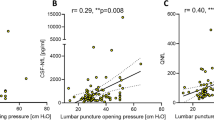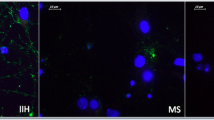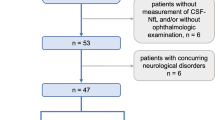Abstract
Although formerly considered as a “benign” disease, the presence of some important problems such as vision loss, resistance to appropriate medical treatment and relapses suggests that neuronal damage might play a role in the pathophysiology of IIH. In order to demonstrate possible neuronal damage/dysfunction participating in IIH pathophysiology, we aimed to investigate the relationship between serum neuron-specific enolase (NSE) levels and clinical features in patients with idiopathic intracranial hypertension (IIH). Thirty-six patients with IIH, diagnosed according to the revised criteria, and 40 age, gender and body mass index-matched healthy controls were enrolled in this study after their consent. Serum samples were evaluated for NSE via enzyme-linked immunosorbent assay method. NSE levels were higher in the IIH group (23.7 ± 14.53 ng/ml) compared to the control group (22.7 ± 13.11 ng/ml), but the difference was not statistically significant (p = 0.824). There were also no statistically significant differences in NSE levels in IIH patients regarding the presence of visual loss, relapse, oligoclonal bands and papilledema. We could not demonstrate any correlations between NSE levels and age, body mass index, cerebrospinal fluid opening pressure and disease duration. The present study is the first to analyze NSE levels in IIH patients and showed no significant difference between patients and controls, and also between different clinical subgroups of IIH patients.

Similar content being viewed by others
References
Wall M, George D (1991) Idiopathic intracranial hypertension A prospective study of 50 patients. Brain J Neurol 114(Pt 1A):155–180
Wakerley BR, Tan MH, Ting EY (2015) Idiopathic intracranial hypertension. Cephalalgia Int J Headache 35(3):248–261. doi:10.1177/0333102414534329
Report of a WHO consultation (2000) Obesity: preventing and managing the global epidemic. World Health Org Tech Rep Ser 894:1–253
Mallery RM, Friedman DI, Liu GT (2014) Headache and the pseudotumor cerebri syndrome. Curr Pain Headache Rep 18(9):446. doi:10.1007/s11916-014-0446-z
Auinger P, Durbin M, Feldon S, Garvin M, Kardon R, Keltner J, Kupersmith MJ, Sibony P, Plumb K, Wang JK, Werner JS, Group OCTS-SCfNIIHS (2014) Baseline OCT measurements in the idiopathic intracranial hypertension treatment trial, part II: correlations and relationship to clinical features. Invest Ophthalmol Vis Sci 55(12):8173–8179. doi:10.1167/iovs.14-14961
Skau M, Brennum J, Gjerris F, Jensen R (2006) What is new about idiopathic intracranial hypertension? An updated review of mechanism and treatment. Cephalalgia Int J Headache 26(4):384–399. doi:10.1111/j.1468-2982.2005.01055.x
McGeeney BE, Friedman DI (2014) Pseudotumor cerebri pathophysiology. Headache 54(3):445–458. doi:10.1111/head.12291
Brea D, Sobrino T, Blanco M, Cristobo I, Rodriguez-Gonzalez R, Rodriguez-Yanez M, Moldes O, Agulla J, Leira R, Castillo J (2009) Temporal profile and clinical significance of serum neuron-specific enolase and S100 in ischemic and hemorrhagic stroke. Clin Chem Lab Med 47(12):1513–1518. doi:10.1515/CCLM.2009.337
Bharosay A, Bharosay VV, Varma M, Saxena K, Sodani A, Saxena R (2012) Correlation of brain biomarker neuron specific enolase (NSE) with degree of disability and neurological worsening in cerebrovascular stroke. Indian J Clin Biochem IJCB 27(2):186–190. doi:10.1007/s12291-011-0172-9
Casmiro M, Scarpa E, Cortelli P, Vignatelli L (2008) Cerebrospinal fluid and serum neuron-specific enolase in acute benign headache. Cephalalgia Int J Headache 28(5):506–509. doi:10.1111/j.1468-2982.2007.01508.x
Teepker M, Munk K, Mylius V, Haag A, Moller JC, Oertel WH, Schepelmann K (2009) Serum concentrations of s100b and NSE in migraine. Headache 49(2):245–252. doi:10.1111/j.1526-4610.2008.01228.x
Azapagasi E, Alehan F, Saygi S, Bayraktar N, Yazici AC (2012) Serum concentrations of neuron-specific enolase in pediatric migraine. Turk J Pediatr 54(2):150–155
Yilmaz N, Karaali K, Ozdem S, Turkay M, Unal A, Dora B (2011) Elevated S100B and neuron specific enolase levels in patients with migraine-without aura: evidence for neurodegeneration? Cell Mol Neurobiol 31(4):579–585. doi:10.1007/s10571-011-9651-z
Friedman DI, Liu GT, Digre KB (2013) Revised diagnostic criteria for the pseudotumor cerebri syndrome in adults and children. Neurology 81(13):1159–1165. doi:10.1212/WNL.0b013e3182a55f17
Hay E, Royds JA, Davies-Jones GA, Lewtas NA, Timperley WR, Taylor CB (1984) Cerebrospinal fluid enolase in stroke. J Neurol Neurosurg Psychiatry 47(7):724–729
Correale J, Rabinowicz AL, Heck CN, Smith TD, Loskota WJ, DeGiorgio CM (1998) Status epilepticus increases CSF levels of neuron-specific enolase and alters the blood-brain barrier. Neurology 50(5):1388–1391
Kropp S, Zerr I, Schulz-Schaeffer WJ, Riedemann C, Bodemer M, Laske C, Kretzschmar HA, Poser S (1999) Increase of neuron-specific enolase in patients with Creutzfeldt-Jakob disease. Neurosci Lett 261(1–2):124–126
Nara T, Nozaki H, Nakae Y, Arai T, Ohashi T (1988) Neuron-specific enolase in comatose children. Am J Dis Child 142(2):173–174
Cheng F, Yuan Q, Yang J, Wang W, Liu H (2014) The prognostic value of serum neuron-specific enolase in traumatic brain injury: systematic review and meta-analysis. PLoS One 9(9):e106680. doi:10.1371/journal.pone.0106680
Royds JA, Davies-Jones GA, Lewtas NA, Timperley WR, Taylor CB (1983) Enolase isoenzymes in the cerebrospinal fluid of patients with diseases of the nervous system. J Neurol Neurosurg Psychiatry 46(11):1031–1036
Beems T, Simons KS, Van Geel WJ, De Reus HP, Vos PE, Verbeek MM (2003) Serum- and CSF-concentrations of brain specific proteins in hydrocephalus. Acta Neurochir (Wien) 145(1):37–43. doi:10.1007/s00701-002-1019-1
Jauch EC, Lindsell C, Broderick J, Fagan SC, Tilley BC, Levine SR, Group Nr-PSS (2006) Association of serial biochemical markers with acute ischemic stroke: the National Institute of Neurological Disorders and Stroke recombinant tissue plasminogen activator Stroke Study. Stroke J Cereb Circ 37(10):2508–2513. doi:10.1161/01.STR.0000242290.01174.9e
Tawk RG, Grewal SS, Heckman MG, Rawal B, Miller DA, Edmonston D, Ferguson JL, Navarro R, Ng L, Brown BL, Meschia JF, Freeman WD (2016) The relationship between serum neuron-specific enolase levels and severity of bleeding and functional outcomes in patients with nontraumatic subarachnoid hemorrhage. Neurosurgery 78(4):487–491. doi:10.1227/NEU.0000000000001140
Acknowledgements
The authors thank the participants for taking part in the study. They also would like to thank Sema Icoz for helping with the preparation of the sera. This work was supported by the Istanbul University Scientific Research Fund (Grant no. BAP-53771).
Author information
Authors and Affiliations
Corresponding author
Ethics declarations
Funding
This study was funded by Istanbul University Scientific Research Fund (Grant no. BAP-53771).
Conflict of interest
The authors declare that they have no conflict of interest.
Ethical approval
All procedures performed in studies involving human participants were in accordance with the ethical standards of the institutional and/or national research committee and with the 1964 Helsinki declaration and its later amendments or comparable ethical standards.
Informed consent
Informed consent was obtained from all individual participants included in the study.
Additional information
Y. Samancı and B. Samancı contributed equally.
Rights and permissions
About this article
Cite this article
Samancı, Y., Samancı, B., Şahin, E. et al. Neuron-specific enolase levels as a marker for possible neuronal damage in idiopathic intracranial hypertension. Acta Neurol Belg 117, 707–711 (2017). https://doi.org/10.1007/s13760-017-0762-2
Received:
Accepted:
Published:
Issue Date:
DOI: https://doi.org/10.1007/s13760-017-0762-2




